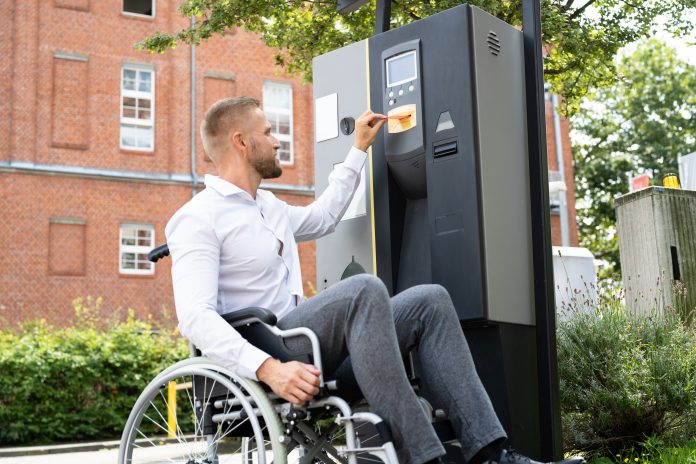Doors, pedestrian crossings and loos are among the essentials we’ve looked at when assessing accessibility. Now we’re adding accessible vending machines to the list – whatever they sell, everyone needs to be able to use them, not just non-disabled people
The challenges go beyond the difficulties presented by door handles, pedestrian crossing buttons and flush systems for loos which have not been designed with consideration for people who have problems with manual dexterity. Vending machines and similar facilities can also present problems with location, height, visibility and more.
The key point to remember is that whatever lengths you go to in making a building accessible, the equipment you put inside should also meet the same standards.
It’s important as well to note that if you get it wrong and you purchase a piece of equipment which makes your environment and services inaccessible then any comeback is on you and not on the supplier of the product.
Modern-day ATMs are set at a lower height for ease of use
You’re the one who risks revenue loss and reputational damage if visitors or staff are unable to use the facilities you provide within your premises. You’re also the one in the firing line if the situation escalates into a discrimination claim.
For a few clues as to good practice take a look at the modern ATMs used by banks. These days they have some set at a lower height for ease of use by people who are short of stature or in a wheelchair.
A different lesson can be learned from the fact that they aren’t always in the ideal location. That’s not an easy issue to solve when the machine is set in a wall and located outside for use 24/7, but a canopy could give protection from wind, rain and glare.
Make use of the flexibility you have in locating accessible vending machines
But you should make the most of the greater flexibility you have in locating accessible vending machines. They should be on a level floor with plenty of space in front to allow a wheelchair to get close enough from the front or the side – one recommendation suggests a space of at least 2400mm by 2400mm.
The controls and the instructions for use should not be too high – a sensible limit would be between 750mm and 1200mm above floor level. The typeface should be large, clear and with enough visual contrast against the background, using upper and lower case characters and universally recognised symbols. It is helpful to also provide them in braille.
Should be possible to operate vending machines with one hand
It should be possible to operate the controls with one hand, and with a clenched fist. Push-button controls, pull handles, levers and a sensors are all good, removing the need to grip or twist.
In the event that all these measures prove inadequate or the user experiences a different problem, it’s useful to have a means of calling for help, and particularly if the machine is used for trains or car parks where penalties can be imposed for the failure to present a ticket.
And whether the user is buying a ticket, a snack bar or a canned drink they need to be able to remove the item safely and simply.
A similar approach should be adopted to lifts, where the controls are often set at waist height, making braille difficult to read.
Reception desks and service counters should also be set at a lower height
As with the ATMs, it’s now well established that reception desks and service counters can also be set at a lower height, but it’s not a good idea to apply that throughout. We became aware of a site where the entire serving counter was 850mm above floor level. That created a new difficulty for the catering staff who struggled to source appliances small enough to fit underneath.
We hear of problems being experienced in libraries, leisure centres, shopping centres, transport stations and interchanges, car parks – essentially wherever some of these facilities are in use. The episode with the service counter underlines the importance of thinking things through – if you purchase something with the aim of improving accessibility for some people, consider whether it might also create obstacles for others.
You might find that the people selling you the equipment will also share advice which is relevant and accurate. Some sales people might have a working knowledge of what’s required and even of the provisions of the Equality Act, but there are others who still refer to it as the DDA.
It’s a case of buyer beware – the responsibility to get it right is on you, not on the person who sold, supplied or fitted the equipment.

















